HMS Victory Copper Sheathing
(c) Antique Metalware Society
Small extracts can be used with acknowledgements to 'Oldcopper.org' website.
Helpful comments are very welcome.
Complete cladding with copper of the underwater hull of a ship had been first used on HMS Alarm in 1761 to prevent attack of the wooden hull by the Teredo worm in tropical waters. The copper was also found to reduce biofouling of the hull very significantly which gave ships a great advantage of speed when compared with those dragging round a vast growth of marine weed. The cladding kept ships in commission at times when others had to be dry-docked or careened on a shore for hull scraping. This significantly enlarged the effective strength of the Navy.
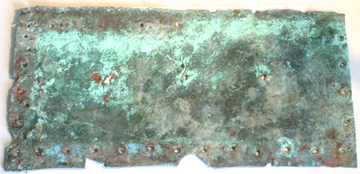 The copper sheets were a nominal 4ft (1220mm) long by 14” (356mm) wide and overlapped at the joints, about 3,500 being needed. Some were smaller and shaped to infill contour changes. They were fixed with nails also made of copper to avoid bimetallic corrosion. At the bows the copper was usually of a thickness equivalent to 32oz weight of copper per square foot. Most of the sides of the hull were clad with 28oz copper but 22 oz sufficed for the stern. This wore sufficiently to need replacement every 20 years or so. The manufacturers marks of a large number of rolling mills can be seen on sheets that have been removed during the restoration. Mostly these date from the late 19th century.
The copper sheets were a nominal 4ft (1220mm) long by 14” (356mm) wide and overlapped at the joints, about 3,500 being needed. Some were smaller and shaped to infill contour changes. They were fixed with nails also made of copper to avoid bimetallic corrosion. At the bows the copper was usually of a thickness equivalent to 32oz weight of copper per square foot. Most of the sides of the hull were clad with 28oz copper but 22 oz sufficed for the stern. This wore sufficiently to need replacement every 20 years or so. The manufacturers marks of a large number of rolling mills can be seen on sheets that have been removed during the restoration. Mostly these date from the late 19th century.
A later development was the use of brass to make the nails. As made, these are stronger and harder and have less tendency to bend when being hammered home. Keir was probably the first to try but his brass was high in iron and not a success. Muntz's development of 60/40 brass with much less iron produced a brass that could be hot worked to the size required. Muntz's Metal Co Ltd.
Thickness of copper sheets used for ships’ cladding
oz/ft2 |
inch |
mm |
32 |
0.043 |
1.1 |
28 |
0.037 |
0.94 |
22 |
0.029 |
0.74 |
The 3,500 sheets weighed nearly 13 tons. The late 19th century sheets now being resold for souvenirs have a composition including impurities of about 0.04% lead, 0.25% arsenic, 0.04% nickel and 0.07% silver. Not surprisingly, this would not pass current standard limits since hot and cold working properties and weldability will be adversely affected. Besides the copper sheets, other souvenirs are available made from the copper and brass nails used to fasten the hull timbers, mostly small but some that are larger. These are made from rods of up to 25mm (1”) in diameter. They were originally all stamped with the government broad arrow mark at regular intervals along their length in order to reduce pilferage by the taking of offcuts. This is said to be the origin of the term ‘to half inch’for ‘pinching’ or stealing.
Maker's Marks found on the copper removed from HMS Victory
John Vivian was born near Truro in Cornwall into a family, the Vivians of Trewan, that was 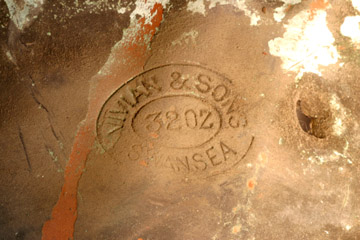 concerned with Cornish mining and the copper industry for several generations. He became a leading mine owner in Cornwall and was encouraged to set up a copper refinery and works in South Wales to establish competition with other refiners and obtain a fair price for Cornish copper. He became a prosperous copper baron in South Wales and eventually bought a controlling interest in the Parys Mountain mines in Anglesey. He was joined in the business by sons Henry Hussey Vivian and John Henry Vivian (1785-1855).
concerned with Cornish mining and the copper industry for several generations. He became a leading mine owner in Cornwall and was encouraged to set up a copper refinery and works in South Wales to establish competition with other refiners and obtain a fair price for Cornish copper. He became a prosperous copper baron in South Wales and eventually bought a controlling interest in the Parys Mountain mines in Anglesey. He was joined in the business by sons Henry Hussey Vivian and John Henry Vivian (1785-1855).
John Bibby was born in 1775. In his teens he started work with a ship’s iron merchant and in 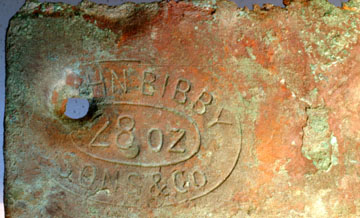 1801 started his own shipbroking business. By 1807 he had shares in seven ships and the shipowning business grew well. He diversified back in to iron merchants in 1927 and in 1839 set up a copper smelting business at Seacombe on the River Mersey to help meet demand for copper sheet for the sheathing of wooden hulls.
1801 started his own shipbroking business. By 1807 he had shares in seven ships and the shipowning business grew well. He diversified back in to iron merchants in 1927 and in 1839 set up a copper smelting business at Seacombe on the River Mersey to help meet demand for copper sheet for the sheathing of wooden hulls.
Copper made by Lambert & Co. (more information would be welcome).
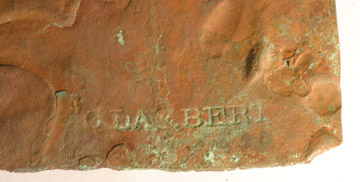
Details of other makers and their marks can be found in: 'Copper and other Sheathing in the Royal Navy', John M Bingeman, J P Bethel, P Goodwin & A T Mack, Int. J. Naut. Arch. (2000) 29, 2: pp218-229).
There are many souvenirs available second hand that date from previous servicing of the cladding.. An early one was a commemorative medal struck in 1905 to commemorate the centenary of the Battle of Trafalgar and the death of Admiral Lord Nelson. These were made from copper cladding taken from the hull during maintenance, before she was permanently dry-docked, and presented to dignitaries via the Civil Service.
Most souvenirs are in the form of cast brass replicas of the side elevation with ‘HMS Victory’ written underneath. These are incorporated in the design of the handles for a variety of items such as door knockers, toasting forks, and bottle openers. The patterns used vary and some have the hull looking more like a galleon with a huge sterncastle than a British ship of the line. Many date from the early 1920s when full preservation needed popular public support in addition to that from the Royal Navy and the Society for Nautical Research. Popular commercial production continued through the 1930s with the ‘HMS Victory’ emblem being one of many from which to choose for the handles for such products as toasting forks, fire irons, knockers and crumb trays to name but a few.
There was a splendid commemoration of the bicentenary of the Battle of Trafalgar in 2005.
Original square-cut brass nail taken from Admiral Lord Horatio Nelson's flagship, HMS Victory,  during her 80-year refurbishment programme.
during her 80-year refurbishment programme.
Brass was favoured over copper when it came to hammering nails into  oak (the primary variety of timber used on board HMS Victory) because of its superior strength, though there is even a slight bend present at the hammered end of this piece. One of the four sides has been cleaned up to reveal two very prominent King's Marks - these were used to identify the material as government property, and thus to discourage theft. On many of the nails and rivets used, the King's Mark would often appear every inch or so thus making it impossible to 'pinch more than an inch', and this is where the saying came from! This is still heavily patinated from age on the other three sides.
oak (the primary variety of timber used on board HMS Victory) because of its superior strength, though there is even a slight bend present at the hammered end of this piece. One of the four sides has been cleaned up to reveal two very prominent King's Marks - these were used to identify the material as government property, and thus to discourage theft. On many of the nails and rivets used, the King's Mark would often appear every inch or so thus making it impossible to 'pinch more than an inch', and this is where the saying came from! This is still heavily patinated from age on the other three sides.
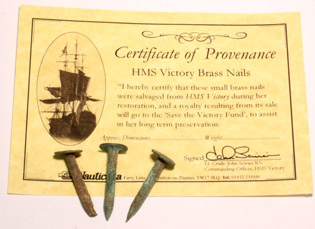 It comes with a certificate of provenance. Length 108mm (4 1/4"). Weight 57g.
It comes with a certificate of provenance. Length 108mm (4 1/4"). Weight 57g.
Brass nails that had been used to secure the cladding sheets sold as souvenirs with a certificate of provenance.